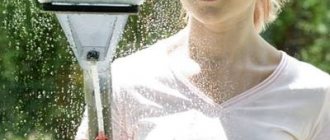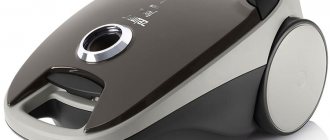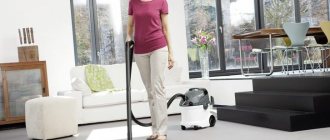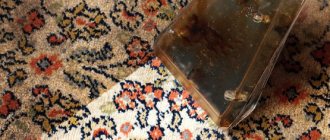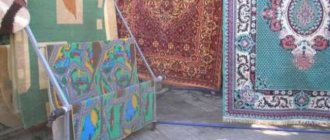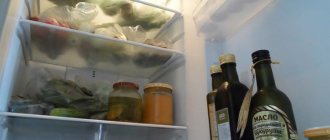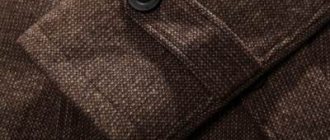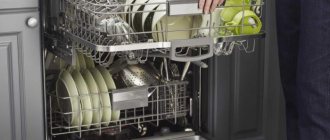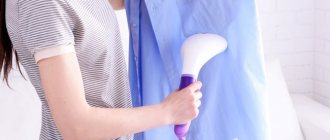There is no housewife who would refuse a vacuum cleaner with a wet cleaning function. This is a very convenient technique that provides really high-quality and fast cleaning of various surfaces.
It will be useful for those who own such a device to learn how to use a washing vacuum cleaner in order to achieve maximum efficiency of its operation and extend the life of the home assistant. The information presented in the article will also be useful to those who are just thinking about purchasing a multifunctional unit.
Operating principle of a washing vacuum cleaner
Using a washing vacuum cleaner allows you to clean without streaks and thoroughly wash the surface, which also quickly becomes dry. This is guaranteed thanks to the operating principle of the device:
- The washing vacuum cleaner has two containers. One contains clean water, the other contains detergent. When you turn on the vacuum cleaner, water is mixed with detergent.
- This solution begins to move along the hose and approaches the nozzle.
- Thanks to the created pressure through the sprayer, the solution begins to wet the contaminated surface, including dust.
- Water absorbs contaminants that have been broken down under the pressure of the solution, and is then sucked back into the vacuum cleaner through a tube and accumulates in another tank.
A hose, bag, filters, nozzles and tubes are included with the vacuum cleaner.
To clearly see the principle of operation of the device, you can watch a video in which you assemble a simple washing vacuum cleaner with your own hands:
Using a washing vacuum cleaner, you can also dry clean the room. It will collect food debris on the floor, animal hair and bird fluff, even pet waste products.
Example of using Karcher Puzzi
Karcher is one of the most famous manufacturers of cleaning equipment. How to use a Karcher Puzzi industrial vacuum cleaner will help you get a more accurate idea of how to use these complex units.
Before starting work, the manufacturer recommends checking the condition of the power cable and suction hose each time.
After this, the following elements are connected in series:
- nozzle - fixed with a union nut;
- suction pipe;
- elbow - fixed with a union nut;
- suction hose;
- spray hose.
The collected elements are connected to a washing vacuum cleaner. In this case, the suction hose is first inserted into the socket on the body, and then the connection between this element and the spray hose is made with the elbow. Particular attention should be paid to the junction of the spray hose with the elbow; a special coupling is designed for this.
In a separate container, you need to mix the detergent composition and clean water in the proportions that are recommended for this particular product. It is better to use warm water (no more than 50°C) to increase cleaning efficiency. In this case, you need to make sure that the coating can withstand contact with warm liquid without damaging its condition.
If you intend to clean delicate surfaces (colored carpet, upholstery), you first need to test the detergent composition and the temperature of the working fluid in an inconspicuous area
The prepared solution is poured into a “clean” container up to the MAX mark. Now you can connect the vacuum cleaner to the power supply. Then press the SUCTION and SPRAY knobs to begin the cleaning procedure.
First, it is recommended to check the resistance of the coating to moisture and cleaner in some inconspicuous place. If the color and texture of the carpet remain unchanged, cleaning can continue. To supply the cleaning solution to the surface, a special lever is provided on the elbow of the washing vacuum cleaner.
The nozzle is moved along the floor covering in such a way that “paths” are formed with a slight overlap. The nozzle cannot be moved in any direction; only reverse motion is used. For periods when direct cleaning needs to be suspended, the nozzle can be hidden in the slot provided for this purpose on the handle.
After the coating has been treated with the solution, you can go over it again without splashing, as with dry cleaning. This will speed up the drying of the surface. When working with areas where there is heavy contamination, it is recommended to spray the composition and pause for about a quarter of an hour.
Before you start cleaning, you need to pour clean water with shampoo dissolved in it into the appropriate container. The concentration and method of dilution depends on the type of product and is indicated in the instructions for it
A short break ensures contact of the composition with dirt and increases cleaning efficiency. After this, you need to treat the surface again as during normal cleaning, and then again, but using only clean water.
When working with chemical-sensitive surfaces (multi-colored carpets, upholstery), you can reduce the concentration of the special product.
Particular care should be taken when working with jute surfaces, which are prone to color loss and deformation when in contact with moisture. For high-pile carpets, after cleaning, additional treatment with a brush or broom in the direction of the pile is recommended. This must be done before the surface dries.
When the cleaning process is completed, first move the SUCTION and SPRAYING handles to their original position, after which the vacuum cleaner can be unplugged. Now it is important to correctly carry out the maintenance procedure for the device. First, empty the “dirty” tank.
To do this, open the housing lid, take out the container and pour the waste water out of it. Do the same if this tank overflows during cleaning. First, of course, you need to unplug the vacuum cleaner and turn the switches.
Then you need to remove and empty the container, put it in place and perform the reverse operations: turn on the device and move the SUCTION and SPRAYING handles to the working position. At the end of cleaning, the compartment is washed with running water.
Now you should empty the “clean” container of any remaining liquid.
They do it like this:
- disconnect the vacuum cleaner from the network;
- relieve pressure inside; for this purpose, there is a lever located on the knee;
- disconnect the spray hose;
- lower the main hose into a container of water;
- turn on the vacuum cleaner and move the SUCTION handle;
- wait until the device pumps the liquid out of the container.
The next stage is washing the working elements of the device. The elbow is connected to the main hose and capillary. Now approximately two liters of ordinary clean water are poured into a “clean” container. There is no need to use a cleaning compound here.
Now you need to turn on the spray SPRAY. The washing process takes one or two minutes. Then the vacuum cleaner should be turned off. Once both tanks are cleaned, they need to be dried. The outside of the housing is wiped with a damp cloth, and its lid is left in the open position while drying.
If servicing a washing vacuum cleaner seems too difficult, you can choose a different type of unit. Models with an aqua filter demonstrate good cleaning quality.
How to wash floors with a vacuum cleaner?
Washing proceeds as follows:
- If there are particles of debris on the surface, you need to sweep the floor with a broom or use the dry dust attachment on a vacuum cleaner.
- Fill the vacuum cleaner with water and detergent.
- Start cleaning the floor. If the vacuum cleaner is powerful, the floor will be dry and shiny in a few minutes.
The washing vacuum cleaner first wets the floor surface, then picks up the contaminated liquid and places it in a special container.
Using a vacuum cleaner is best for cleaning surfaces covered with ceramic tiles or linoleum.
Is it possible to wash laminate flooring with a vacuum cleaner?
It is known that a laminate-covered floor cannot be heavily wetted, but the class of the laminate is of decisive importance. Some specimens are covered with a moisture-protective layer that repels liquids. This laminate has increased strength (class 32, 33). So, it can be washed with a washing vacuum cleaner, but class 31 cannot!
If you decide to do this procedure, it is advisable that the vacuum cleaner be of medium or high power, but not weak. During washing, the vacuum cleaner sprays a solution intended for wet cleaning of the floor, and the surface becomes wet. Only a powerful washing vacuum cleaner can thoroughly dry the floor after itself and prevent liquid from flowing into the cracks.
In order to wash laminate flooring with a vacuum cleaner, you must adhere to a number of recommendations:
- Carry out wet cleaning no more than 2 times a week.
- Do not use alkali as a detergent.
- Do not use liquids containing wax or silicone.
- Do not allow liquids to get into the joints of the boards.
- After some time, rub them with mastic to seal.
- Do not use coarse bristles for cleaning.
- Do not use steam treatment.
In order for the laminate to serve for a long time and have its original appearance, it is better to wipe it with a mop with a microfiber cloth, which wipes well and does not scratch the surface.
Is it possible to wash parquet with a vacuum cleaner?
When wet cleaning parquet, it is recommended to use a well-wrung out cloth. But if you decide to test your parquet for strength and clean it using a washing vacuum cleaner, remember two rules:
- Washing is only permissible for parquet boards that have been well treated with a special impregnation and coated with a protective varnish.
- The vacuum cleaner should be powerful, which will not wet the floor too much and will thoroughly and quickly absorb liquids from the surface.
Peculiarities
One of the structural elements of the device is nozzles, they come in a set of 5 pieces:
- intended for washing floors and cleaning carpets;
- intended for cleaning upholstered furniture;
- necessary for collecting waste from hard-to-reach, narrow places;
- used for cleaning polished wooden surfaces;
- used for cleaning glass.
It is important to pay attention to the length of the power cord and the function of automatically winding and placing it inside the case.
An equally important structural element is the bar. A solid, non-separable rod is considered durable and reliable. Such a rod has a disadvantage in the form of inconvenience during storage and washing.
Collapsible rods are more comfortable during operation, but after several years of use, the likelihood of leaks at the joints increases.
How to wash carpets with a vacuum cleaner
To clean carpets using a washing vacuum cleaner, you need to prepare:
- shampoo for wet cleaning of carpet surfaces;
- clean water to pour into a special container located in the vacuum cleaner;
- brush attachment;
- vacuum cleaner with washing function.
Step-by-step instructions on how to wash a carpet with a vacuum cleaner:
- Clean the carpet with a regular vacuum cleaner using the vibrating brush attachment and remove all excess dust, sand from the street and dirt. This is done so that the filters of the washing vacuum cleaner do not become clogged with large particles of dirt and accumulated dust.
- Before you start cleaning your carpet, you need to conduct a test to find out how the product will affect the carpet surface. This is especially important if you use a detergent that contains chlorine, as it can affect the brightness of the carpet or damage the pile. For the test, you need to soak a sponge in the product and wipe it on an inconspicuous place. If the pile does not undergo any changes, the color of the paint does not fade, then you can start washing the carpet.
- Fill the reservoir with water and add washing shampoo; in this case, it is important to follow the instructions and avoid excess.
- Select the desired brush attachment. It is known that if the pile on the carpet is long, then select a nozzle with long bristles on the brush. When washing a rug or short-pile carpet, use an appropriate brush attachment with shorter bristles.
- Carry out cleaning, during which you need to move the nozzle up and down until the surface is completely clean. It is recommended to treat in small areas for better cleaning.
- After wet cleaning the carpet, it must be dried with a vacuum cleaner. This will take very little time, but you will be able to move on the carpet when the carpet feels completely dry to the touch. This will take about 1.5-2 hours if the pile is short. With long pile, drying will last up to 3 hours.
Such a vacuum cleaner is indispensable if there are long-pile carpets in the house, because it will perfectly clean them of accumulated dust, and the texture will remain unchanged.
Instructions for a unit with an aqua filter
How to properly use a vacuum cleaner with an aqua filter?
Let's look at how to use a vacuum cleaner with an aqua filter:
- For dry cleaning, ordinary water is poured into the aquafilter tank and the procedure is carried out in the usual way.
- If you need to clean a large area or a very dirty surface, then the water needs to be changed during cleaning.
- Once you have finished cleaning, you need to drain the dirty water from the aquafilter container, then rinse the suction and sponge filters and diffuser under the tap.
- Then the filter protecting the engine and the water-repellent filter are cleaned.
- Clean the HEPA filter from dust. If it is very dirty, wash the element under the tap.
- Remove and clean the aqua sprayer. If its microholes are dirty, clean them with a sharp toothpick.
- Finally, wipe the lid and walls of the vacuum cleaner itself with a dampened cloth.
How to wash windows with a washing vacuum cleaner?
To wash windows, you must have a multifunctional vacuum cleaner with the “Window Cleaning” option. It is advisable to have a brush available that washes glass. Cleaning is carried out according to the following instructions:
- Adjust the length of the tube on which the nozzle is attached so that you can reach contaminants in hard-to-reach places.
- Set the water supply level to the “minimum” position; you cannot use it to the “maximum” position, otherwise streaks will remain after washing.
- Start washing the windows from the top and gradually go lower and lower to avoid contamination, runoff and stains.
This cleaning can be used for all windows, except those that have a rubber seal, since it can partially melt when heated.
Functions
This type of household appliance has more extensive functionality when compared to those not equipped with a wet cleaning function.
Functions:
- Collection of large waste.
- Collection of wet debris, moisture and liquids.
- Air humidification in the room being cleaned.
- Air aromatization.
- Clearing clogs in sinks and bathtubs (additional nozzle required).
- Cleaning dirt from floor coverings - tiles, natural stone, linoleum, upholstered furniture, carpet.
- Cleaning vertical surfaces - glass, mirrors, curtains.
- Cleaning the premises and removing pet hair.
What else can be washed with a washing vacuum cleaner?
Using a washing vacuum cleaner, you can remove stubborn stains on upholstered furniture. To do this, clean according to the instructions:
- The washing attachment is selected for the vacuum cleaner.
- The solution is prepared and poured into the barrel.
- Cleaning begins, and the nozzle is carried out from top to bottom. The cleaning agent is applied to the furniture under pressure. It dissolves the dirt, and the vacuum cleaner already sucks up all the dirt.
- Dirty water is poured out, the barrel is rinsed, clean water is poured in without adding detergents.
- Furniture upholstery is rinsed.
Upholstered furniture often has inaccessible places. To clean them, you must use a crevice tool.
An example of cleaning a sofa with detergent is shown in the video:
Advantages
Among the advantages the following can be noted:
- Easy and quick cleaning of horizontal surfaces.
- Quick removal of spilled liquid followed by drying of the surface.
- Availability of a mode with a dry cleaning function.
- Humidification and air purification, very important for patients suffering from respiratory diseases and allergies.
- High-quality cleaning, in which dust is not sprayed, but dissolves in water. Cleaning is always done with clean water, not as is the case with a mop and bucket.
- Cleaning carpets, upholstered furniture, curtains.
- Cleaning sewer pipes for minor blockages.
